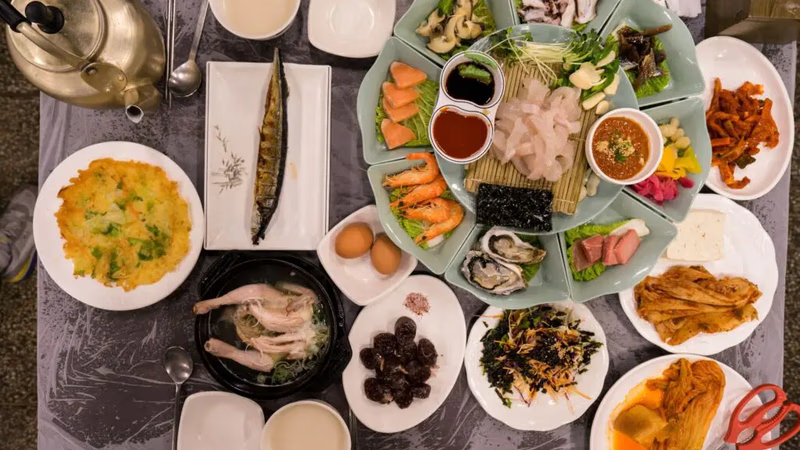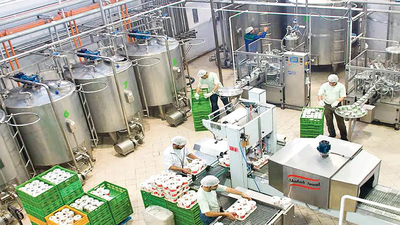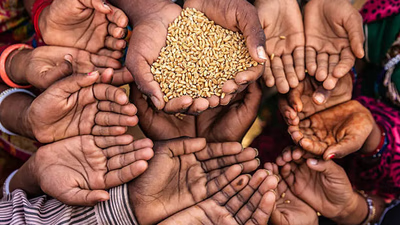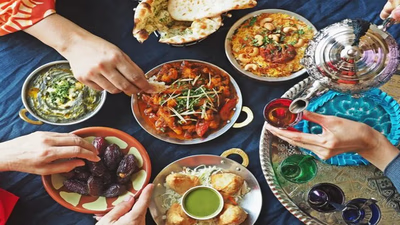
Exploring Asian food culture: rice, noodles, and spices.
Rice and noodles are staple foods in many Asian countries. Rice is a primary food source in East Asia, Southeast Asia, and South Asia, where it is often steamed or boiled and served alongside various dishes. Noodles, made from wheat, rice, or other ingredients, are popular in East Asia and Southeast Asia and are prepared in different ways, such as stir-frying, boiling, or in soups. Asian cuisine is known for its bold and diverse flavors. It often combines sweet, sour, salty, bitter, and spicy elements in a harmonious balance. Ingredients like soy sauce, fish sauce, chili peppers, garlic, ginger, lemongrass, and various spices are commonly used to create these complex flavors.
Asian cooking emphasizes the use of fresh, seasonal ingredients. Vegetables, herbs, and fruits play a prominent role in many Asian dishes. The focus on freshness not only enhances the flavors but also contributes to the overall nutritional value of the food. Stir-frying is a popular cooking technique in many Asian cuisines. It involves quickly cooking bite-sized pieces of meat, vegetables, and/or noodles in a hot wok with oil and sauces. The high heat and rapid cooking help retain the texture, color, and nutrients of the ingredients.
Asia is a big and diverse continent; This region, which is bounded by Turkey in the west, Japan in the east, Kazakhstan and Mongolia in the north, and Indonesia and East Timor in the south, has diverse culinary traditions. Asian consumer food spending will double to more than $8 trillion by the beginning of the new decade compared to $4 trillion in 2019. In this way, Asia will become the largest food and beverage market in the world. According to this report, Asia will be home to 4.5 billion people by 2030 and will accommodate 65% of the world's middle class. $1.55 trillion in investment will be needed by 2030 to meet Asia's growing food demand.
Evidence suggests that people are returning to their daily habits, including eating in restaurants. The return of people to their previous habits, especially eating in restaurants, has increased in countries that have successfully controlled the deadly corona disease. Since the beginning of 2000, tourism in Japan has flourished, and as a result, the number of Japanese food lovers has increased every day. Companies related to the food industry in Japan also used this opportunity to boost their business. On the other hand, fans of Thai food have also increased day by day in different countries, especially in Europe, with the difference that these foods were cheaper than Japanese foods.
It is true that Asian cuisine and characteristics of Asian food culture vary across the Asian region, but they also share commonalities. For example, in Northeast Asia, rice is the main food and noodles are among the foods that are consumed a lot. On the other hand, in Asian cuisine, it is very common to prepare side dishes, which are often prepared with special sauces and spices. In addition to a variety of flavors from sweet, spicy and salty to sour, Asian foods also have various aromas and colors.
It should be said that businesses related to the food industry in Asia, especially those related to basic products and seasonings, have a great impact on the prosperity of this industry in the old continent. In Asia, particularly in Singapore, Japan and China, consumer focus on health is being driven by increasing disposable income, technological innovations in food and beverages, and supportive government policies to increase demand for plant-based alternative products in Asian markets.
Across many Asian countries, street food is an integral part of the food culture. Streets and markets are filled with vendors selling a wide array of snacks, small bites, and quick meals. These street foods often showcase local flavors and provide an opportunity for people to sample a variety of dishes in a casual setting. Asian cuisine features an assortment of condiments and sauces that add depth and flavor to dishes. Examples include soy sauce, hoisin sauce, oyster sauce, sriracha, sambal, miso paste, and various chili pastes. These condiments are used for dipping, marinating, or as a finishing touch.
Each Asian country and region has its distinct culinary traditions and specialties. For instance, Chinese cuisine offers a diverse range of styles, including Sichuan, Cantonese, and Shanghainese. Japanese cuisine includes sushi, tempura, and ramen. Thai cuisine is known for its vibrant flavors and the use of herbs like lemongrass and basil. Indian cuisine features a vast array of spices and vegetarian dishes, while Korean cuisine is known for its spicy and fermented dishes like kimchi.
-

West Asian countries are advancing their food production through modern agricultural practices, including advanced irrigation, hydroponics, and greenhouse cultivation. These methods optimize water use and increase crop yields, particularly in arid regions. The region is also seeing a rise in organic farming, driven by consumer demand for healthier options and sustainable practices. To enhance food safety, traceability systems are being implemented, allowing for the tracking of food products from farm to consumer. The growth of food technology startups is transforming the industry, utilizing AI, blockchain, and data analytics for improved production and distribution. The food packaging industry is evolving, focusing on modern devices to reduce human intervention and enhance efficiency. With a diverse food industry that includes sectors from dairy to snacks, the emphasis on quality packaging and storage methods is crucial for maintaining product integrity. Governments are enforcing stricter food safety regulations, while investments in food processing technologies are increasing.
This includes the development of ready-to-eat meals and convenience foods to meet changing consumer lifestyles. Sustainable packaging solutions are gaining traction, with techniques like modified atmosphere packaging being adopted to prolong shelf life. Additionally, robust cold chain infrastructures are being established to ensure the quality of perishable goods, reflecting a commitment to food safety and quality in the region.
-

Water scarcity is a pressing issue in the Middle East, impacting agricultural productivity and food security. Countries in the region are increasingly reliant on food imports to satisfy domestic needs, leading to vulnerabilities in the face of global price fluctuations and supply chain disruptions, as highlighted during the COVID-19 pandemic. Innovative solutions such as water desalination and drip irrigation are being implemented to mitigate water scarcity. The food industry plays a crucial role in employment and economic value creation in West Asia, with potential for growth due to favorable agricultural conditions and access to quality raw materials. However, ongoing conflicts, such as the war in Syria and the Ukraine crisis, exacerbate food insecurity by disrupting grain supplies and increasing prices. Malnutrition and dietary challenges persist, driven by lifestyle changes and economic factors. Climate change poses additional risks, affecting agricultural productivity and livestock rearing. Addressing food waste is also critical, as significant losses occur throughout the supply chain. Overall, enhancing local agricultural production, diversifying food sources, and implementing sustainable practices are vital for improving food security in the Middle East.
-

Halal food, essential in Middle Eastern cuisine, adheres to Islamic dietary laws, prohibiting pork and alcohol while emphasizing specific preparation methods. Staples like rice, wheat, and legumes form the foundation of many dishes, complemented by flatbreads such as pita and naan. Hospitality is paramount, often showcased through communal meals featuring roasted meats. The cuisine is characterized by grilling, roasting, and slow cooking, with popular dishes including shawarma and kebabs. Middle Eastern food is renowned for its freshness, health benefits, and aromatic qualities, leading to a global interest in its recipes. Mezze, a style of dining with small shared plates, highlights various dips and appetizers. Spices like cumin and cardamom, alongside herbs such as parsley and mint, enhance the flavors of lamb, chicken, and beef dishes. Desserts like baklava and kunefe showcase the region"s rich culinary traditions.
Coffee and tea play significant roles in social interactions, with traditional preparation methods reflecting the region"s hospitality culture. The global appeal of Middle Eastern cuisine continues to grow, driven by its unique flavors and health-conscious ingredients.
-

Asian cuisine is characterized by its diversity and bold flavors, with rice and noodles as staples across many countries. Fresh, seasonal ingredients play a vital role, enhancing both taste and nutritional value. Cooking techniques like stir-frying preserve the texture and nutrients of food. The Asian food market is rapidly expanding, projected to double to over $8 trillion by 2030, driven by a growing middle class and increasing consumer spending. The return of restaurant dining post-pandemic has further fueled this growth. Countries like Japan and Thailand are seeing a rise in food enthusiasts, impacting the global food industry. Street food culture is integral, showcasing local flavors and offering diverse options. Each region has unique culinary traditions, with common elements such as the use of various condiments and spices.
As consumer health awareness rises, there is a shift towards plant-based alternatives, particularly in markets like Singapore, Japan, and China. The food industry in Asia, especially in basic products and seasonings, significantly contributes to the region"s economic prosperity."
-

West Asia faces significant challenges in food production due to arid climates, limited water resources, and urbanization, which restrict agricultural activities. The region"s reliance on food imports makes it vulnerable to global price fluctuations and trade disruptions. Climate change exacerbates these issues, leading to crop failures and livestock losses. Political instability further complicates the situation, disrupting supply chains and causing food shortages. The ongoing conflict in several Middle Eastern countries has led to high food prices and increased food insecurity. The region"s growing population and shifting dietary preferences towards resource-intensive foods heighten the demand for a diverse and sustainable food production system. Inadequate infrastructure and post-harvest management contribute to significant food waste, compounding the challenges of ensuring food security. As countries like Morocco leverage their fertilizer production capabilities, there is a pressing need for effective monitoring of food supply chains and strategic regulation to support local producers and meet consumer needs.
The food industry, while essential, faces pressures that often compromise product quality. Companies like Poya Vision prioritize health and quality in food imports, highlighting the importance of sustainable practices in addressing the region"s food security challenges."
-

Asian food manufacturers produce a wide range of products, including snacks, beverages, and processed foods, reflecting the diverse cuisines of the region. They blend traditional recipes with modern technology to ensure authenticity while meeting contemporary demands for convenience and quality. These manufacturers adhere to strict quality and safety standards, following local regulations and global certifications like ISO and HACCP. With advanced production facilities and a strong export-oriented approach, they cater to both domestic and international markets. Many engage in private label and contract manufacturing, allowing them to customize products for retailers and food service providers. Sustainability and traceability are increasingly prioritized, with manufacturers adopting eco-friendly practices and implementing systems to ensure product authenticity. Research and development play a crucial role in introducing innovative products that align with evolving consumer preferences. Notable companies like Mitsubishi and Tsing Tao lead the industry, showcasing the prominence of Asian food brands globally. Overall, the Asian food manufacturing sector is a dynamic and growing hub, contributing significantly to the global food supply.






